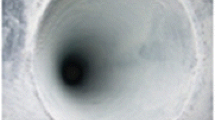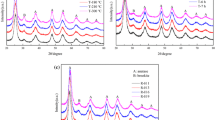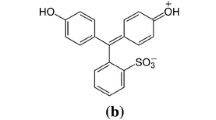Abstract
The raw titania pulp was heated from 350 up to 700 °C and the impact of TiO2 properties on the photocatalytic decomposition of acetaldehyde under UV–Vis light was investigated. The physico-chemical parameters such as BET surface area, extent of surface hydroxylation, phase composition and size of TiO2 crystallites, were measured. It appeared that low-hydroxylated TiO2 prepared at 400 °C with relatively high BET surface area (106 m2/g) and the crystallized anatase phase was the most active for the acetaldehyde decomposition. High hydroxylation of TiO2 surface and the presence of amorphous TiO2 slowed down the photocatalytic process in the gas phase. On the other hand, high concentration of OH groups on TiO2 surface favored the generation of a high amount of OH radicals in an aqueous environment under UV irradiation. A sufficient amount of hydroxyl groups adsorbed on TiO2 surface is needed to facilitate electron–hole separation and OH radicals formation. On the other hand, an excessive content of these groups results in the creation of a barrier for adsorption of acetaldehyde and thus deteriorates photocatalytic process. Additionally, the high concentration of hydroxyl groups on TiO2 surface could accelerate recombination of radicals and reduce its photocatalytic efficiency in the gas phase.









Similar content being viewed by others
References
Fujishima A, Rao TN, Tryk DA (2000) Titanium dioxide photocatalysis. J Photochem Photobiol C Rev 1:1–21
Banerjee S, Dionysiou DD, Pillai SC (2015) Self-cleaning applications of TiO2 by photo-induced hydrophilicity and photocatalysis. Appl Catal B 176:396–428
Hodgson AT, Destaillats H, Sullivan DP, Fisk WJ (2007) Performance of ultraviolet photocatalytic oxidation for indoor air cleaning applications. Indoor Air 17:305–316
Wang XL, Liu LP, Xu HM (2013) Application of photocatalytic concrete paint and its effect of decomposing vehicle exhaust. Adv Mater Res 683:98–105
Ramirez AM, Demeestere K, Belie ND, Mäntylä T, Levänen E (2010) Titanium dioxide coated cementitious materials for air purifying purposes: preparation, characterization and toluene removal potential. Build Environ 45:832–838
Chen J, Poon C (2009) Photocatalytic construction and building materials: from fundamentals to applications. Build Environ 44:1899–1906
Wang R, Hashimoto K, Fujishima A, Chikuni M, Kojima E, Kitamura A, Shimohigoshi M, Watanabe T (1998) Photogeneration of highly amphiphilic TiO2 surfaces. Adv Mater 10:135–138
Takeuchi M, Sakamoto K, Martra G et al (2005) Mechanism of photoinduced superhydrophilicity on the TiO2 photocatalyst surface. J Phys Chem B 109:15422–15428
Guan K (2005) Relationship between photocatalytic activity, hydrophilicity and self-cleaning effect of TiO2/SiO2 films. Surf Coat Technol 191:155–160
Batault F, Thevenet F, Hequet V, Rillard C et al (2015) Acetaldehyde and acetic acid adsorption on TiO2 under dry and humid conditions. Chem Eng J 264:197–210
Jiang Y, Amal R (2013) Selective synthesis of TiO2-based nanoparticles with highly active surface sites for gas-phase photocatalytic oxidation. Appl Catal B 138–139:260–267
Hauchecorne B, Terrens D, Verbruggen S, Martens JA et al (2011) Elucidating the photocatalytic degradation pathway of acetaldehyde: an FTIR in situ study under atmospheric conditions. Appl Catal B 106:630–638
Carrera R, Vázquez AL, Castillo S, Arce EM (2011) Photocatalytic degradation of acetaldehyde by sol-gel TiO2 nanoparticles: effect of the physicochemical properties on the photocatalytic activity. Mater Sci Forum 691:92–98
Chakraborty AK, Chai SY, Lee WI (2008) Photocatalytic behavior of WO3/TiO2 in decomposing volatile aldehydes. Bull Korean Chem Soc 29:494–496
Li D, Haneda H, Hishita S, Ohashi N, Labhsetwar NK (2005) Fluorine-doped TiO2 powders prepared by spray pyrolysis and their improved photocatalytic activity for decomposition of gas-phase acetaldehyde. J Fluor Chem 126:69–77
Azziz RA, Sopyan I (2013) Photocatalytic decomposition of acetaldehyde gas on TiO2–SiO2 thin film photocatalyst—a kinetic analysis. Indian J Chem Technol 20:137–144
Stefanov BI, Niklasson GA, Granqvist CG, Österlund L (2016) Gas-phase photocatalytic activity of sputter-deposited anatase TiO2 films: effect of (001) preferential orientation, surface temperature and humidity. J Catal 335:187–196
Sopyan I (2007) Kinetic analysis on photocatalytic degradation of gaseous acetaldehyde, ammonia and hydrogen sulfide on nanosized porous TiO2 films. Sci Technol Adv Mater 8:33–39
Hou H, Miyafuji H, Saka S (2006) Photocatalytic activities and mechanism of the supercritically treated TiO2-activated carbon composites on decomposition of acetaldehyde. J Mater Sci 41:8295–8300
Bubacz K, Kusiak-Nejman E, Tryba B, Morawski AW (2013) Investigation of OH radicals formation on the surface of TiO2/N photocatalyst at the presence of terephthalic acid solution. Estimation of optimal conditions. J Photochem Photobiol A 261:7–11
Ohtani B, Ogawa Y, Nishimoto S (1997) Photocatalytic activity of amorphous-anatase mixture of titanium (IV) oxide particles suspended in aqueous solutions. J Phys Chem B 101:3746–3752
Chesalov YA, Chernobay GB, Andrushkevich TV (2013) FTIR study of the surface complexes of β-picoline, 3-pyridine-carbaldehyde and nicotinic acid on sulfated TiO2 (anatase). J Mol Catal A 373:96–107
Nagao M, Suda Y (1989) Adsorption of benzene, toluene, and chlorobenzene on titanium dioxide. Langmuir 5:42–47
Colbeau-Justin C, Kunst M (2003) Structural influence on charge-carrier lifetimes in TiO2 powders studied by microwave absorption. J Mater Sci 38:2429–2437
Pichat P (2010) Some views about indoor air photocatalytic treatment using TiO2: conceptualization of humidity effects, active oxygen species, problem of C1–C3 carbonyl pollutants. Appl Catal B 99:428–434
Chen CC, Hu SH, Fu YP (2015) Effects of surface hydroxyl group density on the photocatalytic activity of Fe3+-doped TiO2. J Alloy Compd 632:326–334
Xiong L-B, Li J-L, Yang B, Yu Y (2012) Ti3+ in the surface of titanium dioxide: generation, properties and photocatalytic application. J Nanomater 2012:13. Article ID 831524
Author information
Authors and Affiliations
Corresponding author
Rights and permissions
About this article
Cite this article
Tryba, B., Tygielska, M., Orlikowski, J. et al. Influence of TiO2 hydrophilicity on the photocatalytic decomposition of gaseous acetaldehyde in a circulated flow reactor. Reac Kinet Mech Cat 119, 349–365 (2016). https://doi.org/10.1007/s11144-016-1030-9
Received:
Accepted:
Published:
Issue Date:
DOI: https://doi.org/10.1007/s11144-016-1030-9




